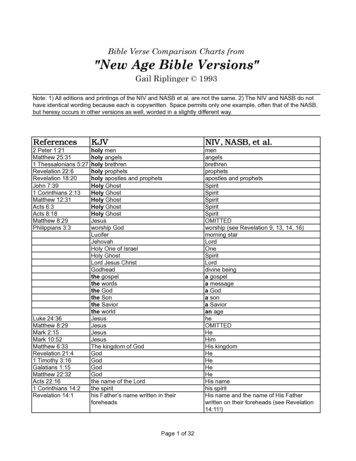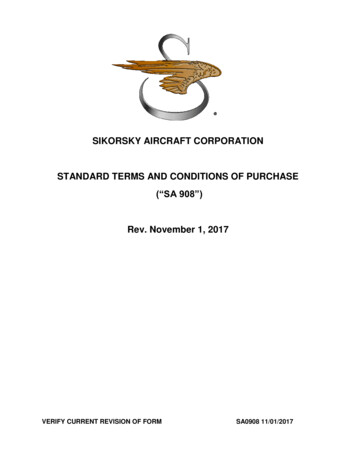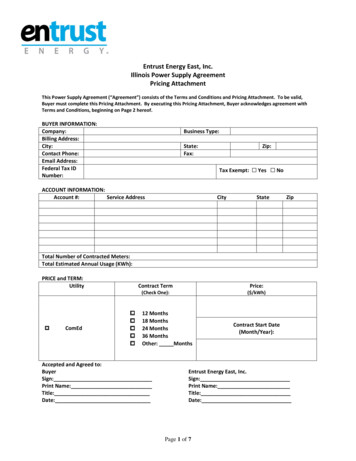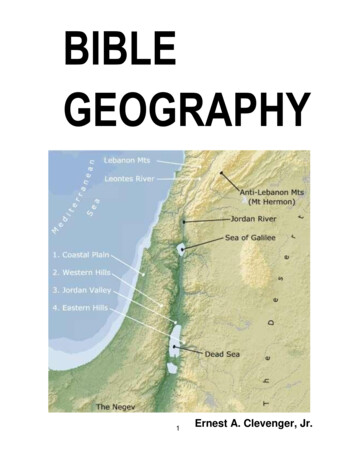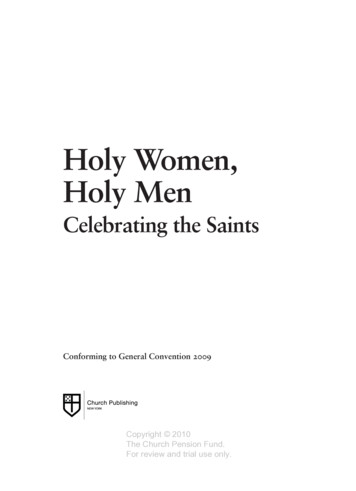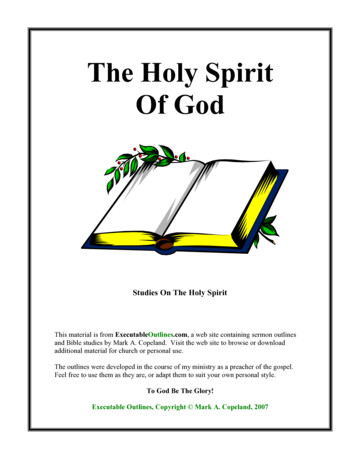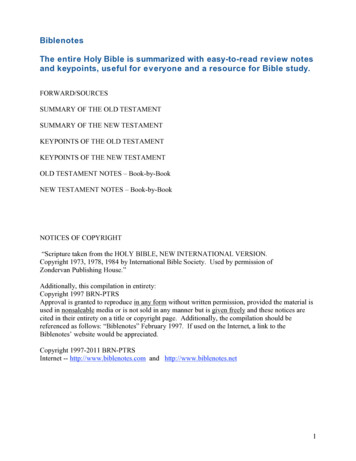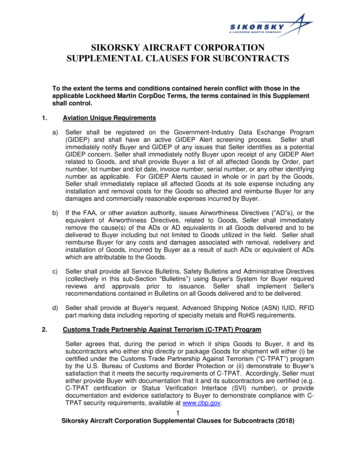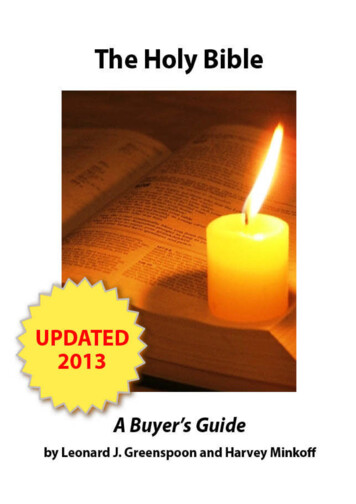
Transcription
The Holy Bible: A Buyer’s Guide 2013 Biblical Archaeology Societyi
The Holy Bible: A Buyer’s GuideThe Holy Bible: A Buyer’s GuideStaff for this book:Sara Murphy, Megan Sauter and Noah Wiener – EditorsRobert Bronder – DesignerSusan Laden – Publisher 2013Biblical Archaeology Society4710 41st Street, NWWashington, DC 20016www.biblicalarchaeology.org 2013 Biblical Archaeology Societyi
The Holy Bible: A Buyer’s GuideAbout the Biblical Archaeology SocietyThe excitement of archaeology and thelatest in Bible scholarship since 1974The Biblical Archaeology Society (BAS) was founded in 1974 as a nonprofit,nondenominational, educational organization dedicated to the dissemination of information aboutarchaeology in the Bible lands.BAS educates the public about archaeology and the Bible through its bi-monthlymagazine, Biblical Archaeology Review, an award-winning web site www.biblicalarchaeology.org,books and multimedia products (DVDs, CD-ROMs and videos), tours and seminars. Our readersrely on us to present the latest that scholarship has to offer in a fair and accessible manner. BASserves as an important authority and as an invaluable source of reliable information.Publishing ExcellenceBAS’s flagship publication is Biblical Archaeology Review. BAR is the only magazine thatconnects the academic study of archaeology to a broad general audience eager to understandthe world of the Bible. Covering both the Old and New Testaments, BAR presents the latestdiscoveries and controversies in archaeology with breathtaking photography and informativemaps and diagrams. BAR’s writers are the top scholars, the leading researchers, the worldrenowned experts. BAR is the only nonsectarian forum for the discussion of Biblical archaeology.BAS produced two other publications, Bible Review from 1985–2005, and ArchaeologyOdyssey from 1998–2006. The complete editorial contents of all three magazines are availableon the BAS Library. The BAS Library also contains the text of five highly-acclaimed books,Ancient Israel, Aspects of Monotheism, Feminist Approaches to the Bible, The Rise of AncientIsrael and The Search for Jesus. Yearly memberships to the BAS Library are available toeveryone at www.biblicalarchaeology.org/library. This comprehensive collection of materials isalso available to colleges, universities, churches and other institutions at www.basarchive.org.Widespread AcclaimThe society, its magazine, and its founder and editor Hershel Shanks have been thesubject of widespread acclaim and media attention in publications as diverse as Time, People,Civilization, U.S. News and World Report, The New York Times, The Washington Post and TheJerusalem Post. BAS has also been featured on television programs aired by CNN, PBS and theDiscovery Channel. To learn more about the Biblical Archaeology Society and subscribe to BAR,go to www.biblicalarchaeology.org. 2013 Biblical Archaeology Societyii
The Holy Bible: A Buyer’s GuideFurther Reading in the BAS Librarywww.biblicalarchaeology.org/libraryOver the years, the Biblical Archaeology Society has printed millions of words on topicsfrom Jesus to Jerusalem, from the Dead Sea Scrolls to scientists' fear of the approaching deathof the Dead Sea itself. Each of the over 6000 we have published in the past 35 years is fullyavailable and fully searchable in the online BAS Library. Every photograph, more than 18,500 ofthem, is also fully viewable--along with the captions, of course.Whether it's to research a paper, to prepare a sermon, to deepen your understanding ofscripture or history, or simply to marvel at the complexity of the Bible, the most important book inhistory, the BAS Library is an invaluable tool that cannot be matched anywhere else. Find outmore at www.biblicalarchaeology.org/library.Bailey, Lloyd R. “What a Concordance Can Do for You,” BAR 10:06.Beegle, Dewey M. “What Does the Bible Say?” BAR 08:06.Cross, Frank M. “New Directions in Dead Sea Scroll Research I: The Text Behind the Text of theHebrew Bible,” BR 01:02.Epp, Eldon. “Should ‘The Book’ Be Panned?” BR 02:02.Fleming, James. “Putting the Bible on the Map,” BAR 09:06.Greenspoon, Leonard J. “Mission to Alexandria: Truth and Legend About the Creation of theSeptuagint, the First Bible Translation,” BR 05:04.Harrelson, Walter, “What Is a Good Bible Dictionary?” BAR 12:06.LaSor, William Sanford. “Learning Biblical Languages,” BAR 13:06.Minkoff, Harvey. “Problems of Translations,” BR 04:04.Additional Further ReadingBailey, Lloyd R, ed. The Word of God: A Guide to English Versions of the Bible. Atlanta: JohnKnox, 1982.Comfort, Philip W. The Complete Guide to Bible Versions. Wheaton, IL: Tyndale House, 1991.Kubo, Sakae and Walter F. Specht. So Many Versions? Grand Rapids, MI: Zondervan, 1983. 2013 Biblical Archaeology Societyiii
The Holy Bible: A Buyer’s GuideTable of Contents 2013 Biblical Archaeology Societyiv
The Holy Bible: A Buyer’s GuideIntroductionAre you looking to buy a Bible? If you’re anything like me, the first place you would look ison Amazon.com. That’s the easiest and fastest way for me to learn what’s available, and abouthow much I can expect to spend.But if you search for “Holy Bible” in Amazon’s Books section, you are faced with 75,996results—dozens of different translations and versions, hundreds of editions and countlessvarieties of packaging designed for every conceivable audience in a seemingly endless list ofentries.Unless you know in advance which exact translation and edition is the one for you, theamount of choice is dizzying. The Holy Bible: A Buyer’s Guide is designed to help you sortthrough Bible translations and editions, and to help you make the important choice about whichBible to purchase. Written by prominent Biblical scholars Leonard J. Greenspoon and HarveyMinkoff, this free e-book will guide you through 27 different Bible versions and address theircontent, text, style and religious orientation.New Bible editions and translations are published every year, and this newly updatededition features discussions by Leonard Greenspoon on six new Bible versions published through2013, including excerpts from the Bibles’ introductions, the opening verses in Genesis andGreenspoon’s remarks on the translation, style and theology of each edition.This newly updated free e-book will serve as a valuable guide to choosing the Bible thatis right for you.Sara MurphyWebmaster, Biblical Archaeology Society2010Updated by Noah WienerWeb Editor, Biblical Archaeology Society2013 2013 Biblical Archaeology Societyv
The Holy Bible: A Buyer’s GuideThe Holy Bible: A Buyer’s GuideBy Leonard J. GreenspoonWalk through the religion section of any major bookstore, and you’ll see an amazingarray of Bibles. The broad selection of translations (also called versions)—and the seeminglyendless ways in which they are packaged—is without historical precedent. But for many people, itis also bewildering, if not frustrating. Rather than the “blessing” it could and probably should be, itmay be off-putting. When faced with a host of adjectives like “new” and “revised,” thoughtfulbuyers might well ask, What was wrong with the “old” or “traditional” or, dare I say it, the“original”?And it doesn’t stop there. How can a buyer tell when a Bible is a different translation (orversion) or the same old text in a new coat? Some publishers put out several translations. Oxford,for example, prints copies of the New Revised Standard Version, the Jewish Publication SocietyTanakh, the New American Bible, the New King James Version, the old King James Version andmore. And several publishers put out the same translations: Eight different publishers have beengiven broad licenses to publish the New Revised Standard Version, for example. And sometimespublishers put out one translation under numerous different titles. Zondervan’s Devotional Biblefor Dad, Revolution: The Bible for Teen Guys, and True Images: The Bible for Teen Girls all 2013 Biblical Archaeology Society1
The Holy Bible: A Buyer’s Guidecontain the same translation (the New International Version—the most popular translation today)with distinctive covers on the outside and different annotations, devotional aids and interpretivematerials on the inside.Some Bibles are aimed at specific religious groups, but this is not always clear from thetitle. How is a Bible buyer to know that the New American Bible is prepared by and for RomanCatholics, while the similarly named New American Standard Bible is aimed at conservativeProtestants?On the following pages, I try to answer such questions in as straightforward, objectiveand succinct a manner as I can. With this goal in mind, I have chosen 21 versions or families ofversions. After providing some basic publication data for the edition I used, I offer a quotationfrom each version’s own introduction that highlights its distinctive features or accomplishments. Ithen cite the same verses, Genesis 1:1–2, for each version and offer my own comments.My Bible guide is far from the first such effort, nor will it be the last. I hope to distinguishmy analysis from others by allowing each version to speak on its own behalf.I have grouped the translations in three broad categories: literal; nonliteral with extendedvocabulary; and nonliteral with limited vocabulary or colloquial language. The literal versionscome closest to providing a word-for-word translation in terms of the grammar, vocabulary andstyle of the original; nonliteral versions with extended vocabulary attempt to provide a Bible thatremains close to the original but makes use of more up-to-date vocabulary and style; the othernonliteral versions restrict the scope of their vocabulary and the complexity of their grammar.Each of these approaches has its own appeal and drawbacks; for example, a literal versionbrings modern readers closest to the ancient text, but often at the expense of intelligibility; theless literal a version is the easier it is for today’s readers to comprehend, but readers can easilylose the feeling that they are dealing with an ancient text.Not every reader will agree with my approach. Rest assured, I am under no illusions: Mywords, unlike Sacred Writ, are not inscribed in stone. In this admission I am in excellent company:The translators of the King James Version made much the same point in their introduction! 2013 Biblical Archaeology Society2
The Holy Bible: A Buyer’s GuideNew Edition of The Buyer’s Guide—Revised 2013At the request of the editors of BAR, I have expanded my “Buyer’s Guide” through theaddition of six new English-language versions of the Bible, most of which had not been published(or fully published) when the “Guide” first appeared in Fall 2005. I am grateful for this opportunity,especially since the production of new versions has continued unabated since that time.At least one of these new versions falls into each of the categories I set up earlier: LiteralTranslations, Non-Literal Translations (with Extended Vocabulary) and Non-Literal Translations(with Limited Language). At the same time, these new editions do exhibit some features not seenin earlier translations, especially those that allow for enhanced internet availability in addition totraditional print copies.I have tried to fashion the new entries so that they fit in seamlessly with the earlier format.After giving basic publication information about each version, I provide extended quotations fromthe introductions (or other prefatory materials) themselves. In this way I allow each translator orgroup of translators to express in their own words what they understand to be the distinctive ordefining characteristics—stylistically, theologically and in terms of paratextual information (varioustypes of footnotes, appendices, maps and other graphics, etc.)—of their version.I then present the first two verses of the first chapter of the first book of the Hebrew Bible(that is, Genesis 1:1-2) in the words of each version. There follow my own observations abouteach translation. To a large extent, I am guided by the translators themselves; that is, my primaryfocus is on how well the translators carry out the goals they themselves have set. At the sametime, I do have views of my own, which I readily offer without (I hope) clouding the reader’s visionof an assessment of each version on its own terms. This is not always an easy task, but it is onethat I think is important.I have reason to think that I have achieved a satisfactory balance. This feeling comesfrom the largely positive response that the “The Buyer’s Guide” has garnered among individualsfrom different faith communities as well as from those who do not identity with any community. Ilook forward to continued interaction with interested individuals. For me, such conversations arethe best way to gain an understanding of how the Word can most effectively be delivered to theworld we all inhabit. 2013 Biblical Archaeology Society3
The Holy Bible: A Buyer’s GuideLiteral TranslationsThe NET Bible (NET Bible)Edition: The NET Bible. New EnglishTranslation Biblical Studies Press. 2005.The cover spine includes this wording: “with60,932 translators’ notes.”Click here to purchaseIntroduction: “There is an average of two translators’ notes for each Biblical verse. The notesalone are the cumulative result of hundreds of thousands of hours of Biblical and linguisticresearch. The translator’s notes, most of which were created at the same time as the initial draftsof the translation itself, enable the reader of the NET Bible to ‘look over the shoulders’ of thetranslators as they worked.The NET Bible is a completely new translation. The project began on a rainy night in November1995 in Philadelphia, Pennsylvania at the annual meeting of the Society of Biblical Literature.The name that was chosen reflects our goals to provide the Bible to the internet audience inelectronic form in addition to the more traditional printed media.Faithfulness to the Hebrew, Aramaic and Greek in which the Biblical documents were originallywritten was the primary concern. The ultimate objective of the NETS Bible is to be accurate,readable, and elegant. A second major objective for the NETS Bible was the clarity of thetranslation for the modern reader. This concern for clarity extended to the literary quality andreadability of the NET Bible. The NET Bible strives for accuracy by translating passagesconsistently and properly within their grammatical, historical, and theological context.Grammatical context is the most important.” 2013 Biblical Archaeology Society4
The Holy Bible: A Buyer’s GuideGenesis 1:1–2: In the beginning God created the heavens and the earth. Now the earth waswithout shape and empty, and darkness was over the surface of the watery deep, but the Spirit ofGod was moving over the surface of the water.My remarks: The NET Bible is, in my view, one of the two versions (the NAB being the other) inthis update that fall within the category of “literal.” Its rendering of Genesis 1:1-2 reflects thewording of the Hebrew, although it smooths over the structure of the original. It is the onlytranslation that I can recall that uses the adversative conjunction “but” (rather than “and”) in v 2;although this is admittedly only a small point, I find this usage thought provoking. Nonetheless,what is most striking about the NET Bible is not its text, but its extensive footnotes. For Genesis1:1-2, there are fifteen notes, ten of which are translators’ notes. Because of this extensiveannotation—which may well appear as overkill to some (although not to the NET editors and,presumably, its target readers)—only v 1 and (most of) v 2 are found on the first page of thetranslation itself. 2013 Biblical Archaeology Society5
The Holy Bible: A Buyer’s GuideKing James Version (KJV)Edition: First published in 1611Click here to purchaseIntroduction: “Truly (good Christian Reader) we never thought from the beginning, that weshould need to make a new Translation, nor yet to make of a bad one a good one . but to makea good one better, or out of many good ones, one principal good one, not justly to be exceptedagainst; that hath been our endeavor, that our mark.”Genesis 1:1–2: In the beginning God created the heaven and the earth. And the earth waswithout form, and void; and darkness was upon the face of the deep. And the Spirit of God movedupon the face of the waters. 2013 Biblical Archaeology Society6
The Holy Bible: A Buyer’s GuideNew King James Version (NKJV)Edition: Holy Bible: The New King JamesVersion, Containing the Old and NewTestaments (Nashville: Thomas NelsonPublishers, 1982)Click here to purchaseIntroduction: “In harmony with the purpose of the King James scholars, the translators andeditors of the present work have not pursued a goal of innovation . [This translation] seeks topreserve all of the information in the text, while presenting it in good literary form.“The translators have sought to maintain that lyrical quality which is so highly regarded in theAuthorized Version . Where obsolescence and other reading difficulties exist, present-dayvocabulary, punctuation, and grammar have been carefully integrated.”Genesis 1: In the beginning God created the heavens and the earth. The earth was without form,and void; and darkness was on the face of the deep. And the Spirit of God was hovering over theface of the waters. 2013 Biblical Archaeology Society7
The Holy Bible: A Buyer’s GuideThe 21st Century King JamesVersion (KJ21)Edition: The Holy Bible: The 21st CenturyKing James Version, Containing The OldTestament and The New Testament (Gary,SD: 21st Century King James BiblePublishers/Deuel Enterprises, 1994)Click here to purchaseIntroduction: “The KJ21 is unique among modern Bibles in that it is closer in language to theoriginal King James Version than any other Bible copyrighted in the twentieth century . Certainwords which are not used in general conversation today, such as thee, thy, thou, hath, art,cometh, etc. have been retained in the KJ21, because they are readily understood and haveremained an eloquent and beautiful part of our traditional language of worship and prayer . Wehave steadfastly resisted any attempt to subject the Word of God to the vagaries of any currentstate of knowledge, culture, or political whim.”Genesis 1: In the beginning God created the heaven and the earth. And the earth was withoutform and void, and darkness was upon the face of the deep. And the Spirit of God moved uponthe face of the waters.My remarks: In my opinion, a copy of the King James Version belongs in every household. Andthis holds true not only for Protestants, but also for Roman Catholics and Orthodox Christians,Jews, adherents of other religions, and believers in none. The KJV is not just an English classic; itis the English classic, and everyone should have easy access to its elegant diction and cadence.With its frequent “and . and . and” structure (as in “And God saw the light and God called thelight Day”) and such expressions as “It came to pass,” the KJV replicates in English many of thecharacteristic features of biblical Hebrew, thereby qualifying it as a literal translation. 2013 Biblical Archaeology Society8
The Holy Bible: A Buyer’s GuideBut the KJV translators entertained no illusions that their work was timeless or immutable. Boththe NKJV and the KJ21 provide today’s readers with a relatively light reworking of the 17thcentury King James Version.The KJ21, with its retention of pronouns like “thee” and verbal forms such as “cometh” and “art,”retains a good deal of the KJV’s flavor; at the same time, it modernizes much of the oldervocabulary. Thus, to name only a few, “Holy Ghost” becomes “Holy Spirit,” “carriage” is replacedby “baggage,” and “gins” by “traps.”The NKJV is a lovingly realized updating of the KJV that will appeal to those who find many of theKJV’s archaic features (such as the use of “thee” and “thy”) off-putting, but nonetheless drawstrength from its overall style and structure. It is surely easier for modern readers to comprehendthan its almost 400-year-old predecessor. 2013 Biblical Archaeology Society9
The Holy Bible: A Buyer’s GuideNew American Standard Bible(NASB)Edition: New American Standard Bible:Updated Edition (Anaheim, CA: FoundationPublications, 1996)Click here to purchaseIntroduction: “The attempt has been made to render the grammar and terminology incontemporary English. When it was felt that word-for-word literalness was unacceptable to themodern reader, a change was made in the direction of a more current English idiom.”Genesis 1: In the beginning God created the heavens and the earth. The earth was formless andvoid, and darkness was over the surface of the deep, and the Spirit of God was moving over thesurface of the waters.My remarks: By the late 19th century, it had become apparent that the King James Version wasin need of substantive and substantial revision. In 1870, the Church of England commissioned 50British and American clerics and scholars to revise and correct the text. Their improvedtranslation was published in the 1880s as the English Revised Version. An American edition,containing the preferences of the American scholars involved in the project, appeared in 1901. Itwas called the American Standard Version. The NASB is an update of this American StandardVersion, and is thus firmly rooted in the KJV family. As such, it tends toward the literalrepresentation of the Hebrew and Greek originals in vocabulary and grammar that conform toAmerican usage. The most recent revision (in 1995) has added a bit more grace and fluidity to itsstyle, while in no way detracting from its usefulness as a trustworthy guide to the ancient text. 2013 Biblical Archaeology Society10
The Holy Bible: A Buyer’s GuideRevised Standard Version (RSV)Edition: The Bible: Containing the Old andNew Testaments, Revised Standard Version(National Council of the Churches of Christin the USA, 1952)Click here to purchaseIntroduction: “A major reason for revision of the King James Version is the change since 1611 inEnglish usage. Many forms of expression have become archaic, while still generally intelligible.Other words are obsolete and no longer understood by the common reader. The greatestproblem, however, is presented by the English words which are still in constant use but nowconvey a different meaning from that which they had in 1611 and in the King James Version. [Eg.,in the KJV “prevent” means “precede” and “convince” means “convict.”] . The Revised StandardVersion Bible seeks to preserve all that is best in the English Bible.”Genesis 1: In the beginning God created the heavens and the earth. The earth was without formand void, and darkness was upon the face of the deep; and the Spirit of God was moving over theface of the waters. 2013 Biblical Archaeology Society11
The Holy Bible: A Buyer’s GuideNew Revised Standard Version(NRSV)Edition: New Revised Standard VersionBible (National Council of the Churches ofChrist in the United States of America, 1989)Click here to purchaseIntroduction: “The Committee has followed the maxim, ‘As literal as possible, as free asnecessary.’ As a result, the New Revised Standard Version (NRSV) remains essentially a literaltranslation . In references to men and women, masculine-oriented language should beeliminated as far as this can be done without altering passages that reflect the historical situationof ancient patriarchal culture . We have resisted the temptation to introduce terms and phrasesthat merely reflect the current moods.”Genesis 1: In the beginning when God created the heavens and the earth, the earth was aformless void and darkness covered the face of the deep, while a wind from God swept over theface of the waters.My remarks: Almost every college student taking a Bible class has made use of the RSV or theNRSV, which are likely to remain the “gold standard” of the academic world for some time. Thisstatus is in large part derived from the fact that the RSV translation committee, and in its wake theNRSV translation committee, was the first (and still the only) major project to actively involveProtestant, Catholic, Orthodox Christian and Jewish scholars, thereby implementing a trulyecumenical, multireligious dialogue that, for example, produced the first Old Testament text with“young woman” rather than “virgin” at Isaiah 7:14.The publication of the NRSV has not led to the “abandonment” of the RSV, as many hadanticipated. Some prefer the “gender-specific” renderings of the earlier RSV translation, whileother readers favor its overall tendency to provide more literal representations than does its“successor.” 2013 Biblical Archaeology Society12
The Holy Bible: A Buyer’s GuideEnglish Standard Version (ESV)Edition: The Holy Bible: English StandardVersion, Containing the Old and NewTestaments (Wheaton, IL: CrosswayBibles/Good News Publishers, 2001)Click here to purchaseIntroduction: “Each word and phrase in the ESV has been carefully weighed against the originalHebrew, Aramaic, and Greek to ensure the fullest accuracy and clarity and to avoid undertranslating or overlooking any nuance of the original text .“The ESV is an ‘essentially literal’ translation that seeks as far as possible to capture the precisewording of the original text and the personal style of each Bible writer . In each case theobjective has been transparency to the original text, allowing the reader to understand the originalon its own terms rather than on the terms of our present-day culture.”Genesis 1: In the beginning, God created the heavens and the earth. The earth was without formand void, and darkness was over the face of the deep. And the Spirit of God was hovering overthe face of the waters.My remarks: The translators of the ESV readily acknowledge their debt to the KJV and otherearlier versions. It could be said that the ESV stands in the KJV tradition without being part of thefamily. Thus, for example, the KJV’s (and the Hebrew original’s) reliance on “and . and . and” islargely retained, while an effort is made to distinguish in English varying styles among Old andNew Testament writers. In this way, its English style and vocabulary may be consideredappropriately “biblical” and constitute a very sensible and sensitive balance between concern forthe ancient originals and for modern readers. 2013 Biblical Archaeology Society13
The Holy Bible: A Buyer’s GuideThe New American Bible RevisedEdition (NABRE)Edition: The New American Bible RevisedEdition Catholic Book Publishing Corp. NewJersey, 2010.Click here to purchaseIntroduction: “This new edition is a thorough revision of the already excellent New American OldTestament of 1970. Work on most books of the Old Testament [was] begun in 1994 andcompleted in 2001. The revisers aimed at making use of the best manuscript traditions available,translating as accurately as possible, and rendering the result in good contemporary English. Inmany ways, it is a more literal translation than the original NAB and has attempted to be moreconsistent in rendering Hebrew (or Greek) words and idioms. In translating the Psalter, specialeffort was made to provide a smooth, rhythmic translation for easy singing or recitation, and toretain the concrete imagery of the Hebrew.Where the Old Testament translation supposes the revised text, no additional remarks arenecessary. Where the translators have departed from those received texts, such changes arerecorded in the revised edition of Textual Notes on the New American Bible.”Genesis 1:1–2: In the beginning, when God created the heavens and the earth—and the earthwas without form or shape, with darkness over the abyss and a mighty wind sweeping over thewaters—My remarks: As a revision of the NAB, the best way to evaluate NABRE is to compare it with theearlier English text: “In the beginning God created the heavens and the earth. The earth wasformless and void, and darkness was over the surface of the deep, and the Spirit of God wasmoving over the surface of the waters.” As noted above, the revisers themselves judged theirproduct “a more literal translation than the original NAB.” For Genesis 1:1-2, this phenomenon is 2013 Biblical Archaeology Society14
The Holy Bible: A Buyer’s Guidemost easily observed in the structure (rather than the vocabulary) of the English. The use ofdashes in NABRE, along with the absence of a verb after “darkness” and the fashioning of“sweeping” as a participle, are more accurate— that is, more literal—reflections of the underlyingHebrew. On the other hand, the “composite” clause at the beginning of v 1, while it embodiesboth of the main translation (and interpretative) options, cannot be said to be more literal, and therendering “mighty wind,” while less objectionable in terms of inter-religious usage, strikes me astheologically (if not climatologically) challenged. In spite of these reservations, I am confident thatthis revision will spark rich dialogue and reflection on the part of English-speaking RomanCatholics, who are the target audience for the new version. 2013 Biblical Archaeology Society15
The Holy Bible: A Buyer’s GuideThe New American Bible (NAB)Edition: The New American Bible withRevised New Testament and RevisedPsalms (Nashville: Catholic Bible Press,1991)See the updated NABRE version on page14.Click here to purchaseIntroduction: “[The purpose of this work is] to translate the sacred scriptures from the originallanguages or from the oldest extant form of the text, and to present the sense of the biblical textin as correct a form as possible.“The collaboration of scholars who are not Catholic fulfills the directive of the Second VaticanCouncil, not only that ‘correct translations be made into different languages especially from theoriginal texts of the sacred books,’ but that, ‘with the approval of the church authority, thesetranslations be produced in cooperation with s
Tanakh, the New American Bible, the New King James Version, the old King James Version and more. And several publishers put out the same translations: Eight different publishers have been given broad licenses to publish the New Revised Standard Version, for example. And sometimes publishers
